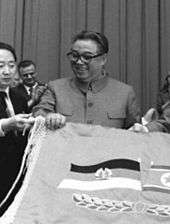October Yusin
The October Yusin (Korean: 시월유신, Hanja: 十月維新, RR: Siwol Yusin) or October Restoration was an October 1972 South Korean self-coup in which President Park Chung-hee assumed dictatorial powers. Park had come to power as the head of the Supreme Council for National Reconstruction after the May 16 coup of 1961, and in 1963 he won elections and assumed office as civilian president.
Background
July 4th North–South Joint Declaration

On May 4, 1972, the director of Korea Central Intelligence Agency (KCIA), Lee Hu-rak, went to North Korea and met Kim Il-sung. They announced the North-South Joint Declaration with the three principles of the reunification. After the declaration, a direct phone cable was installed between Seoul and Pyeongyang. Enthusiasm for reunification was heating up. Park used it as a pretext for the amendment of the constitution.
Third term of the presidency
Under the Third Republic's constitution, the president was limited to two terms in office. However, the National Assembly, dominated by Park's Democratic Republican Party, amended the Constitution in 1969 to allow a third term. He was re-elected in the 1971 presidential election.
1971 legislative election
The 8th general election was held on May 5, 1971. Park's Democratic Republican Party took 113 seats out of 204. However, it didn't reach the minimum condition to pass a constitutional amendment. It required the concurrence of two thirds or more of the total members of the National Assembly. Therefore, Park couldn't amend the constitution through the lawful procedure.
Timeline
1969 referendum
In 1969, with the amendment of the constitution, a third term as President was legalized for Park Chung-hee.
Declaration of a state of emergency
In October 17, 1972, Park announced a presidential special declaration. After that, Park dissolved the National Assembly, suspended the constitution and declared martial law. Universities were closed also. The Press, the speech, and the newscast was censored under a state of emergency. Work was then begun on a new constitution, which was resolved in October 27 by the emergency State Council.
Coup
The National Assembly was dispersed and the constitution was revised by Park Chung-Hee. This paved the way for Park to take authoritarian and lifetime power without any check.
The event was named after Japan's 1868 Meiji Restoration. Park Chung-Hee, a former officer in the Japanese-controlled Manchukuo Imperial Army, admired Japanese politics, and called his self–coup Yusin (or Yushin), the Korean pronunciation of the Japanese word Ishin (restoration).
The new administration established after the coup is now called the Yusin Regime (유신체제, 維新體制) or Yusin Dictatorship (유신독재, 維新獨裁).
Constitution of the Fourth Republic
Under the Yusin regime, the Constitution of the Third Republic of Korea was replaced by the Yusin Constitution, the Constitution of the Fourth Republic.
In accordance with the Yusin Constitution, an electoral college called "Tongil Juche Gungmin Hoeui" (통일주체국민회의, the National Council for Unification) was set up. Tongil Juche Gungmin Hoeui became a sovereign organization that elected the president and one third of assemblymen. Furthermore, unlike its predecessor, the new constitution lacked provisions regarding the number of presidential term limits; elections were held every six years, but there were no constitutional restrictions on the number of terms one could serve. It essentially guaranteed presidency for life for Park Chung-Hee. In addition, it also allowed the president to declare Gingeup Jochi (긴급조치권, meaning "emergency measure") which allowed the president to promulgate laws without ratification by the National Assembly.
In short, the Yusin Constitution endowed the president with near-absolute power. The president could appoint one–third of the members of the National Assembly, guaranteeing him a parliamentary majority and control over the legislative branch.
Aftermath
The Yusin Regime was soon challenged by activists from groups such as college students, artists, religious leaders, and the opposition. Park suppressed these protests by force. In the People's Revolutionary Party Incident, eight persons were executed for treason. The only evidence, their confessions, were extracted by torture, and the executed are now generally considered to have been innocent. Nevertheless, the resistance to the Yusin Regime continued and caused serious social unrest.
The Yusin Regime was criticized internationally for human rights abuse. The American Carter Administration warned that United States military forces might be withdrawn from South Korea unless Park eased off his dictatorship.
On October 26, 1979, the "10.26 Incident" occurred—the assassination of Park Chung–hee by members of the Korean Central Intelligence Agency.
Park's assassination removed the main impetus of the Yusin Regime. Although the military took power by consecutive coups (the 12.12 Coup d'état and the 5.18 Incident) after Park's death, there was a general consensus that the Yusin Constitution was no longer viable. The military junta promulgated the Constitution of the Fifth Republic, which officially replaced the Yusin Constitution in 1980. This new constitution was liberal compared to the Yusin Constitution, although it was still an authoritarian one.